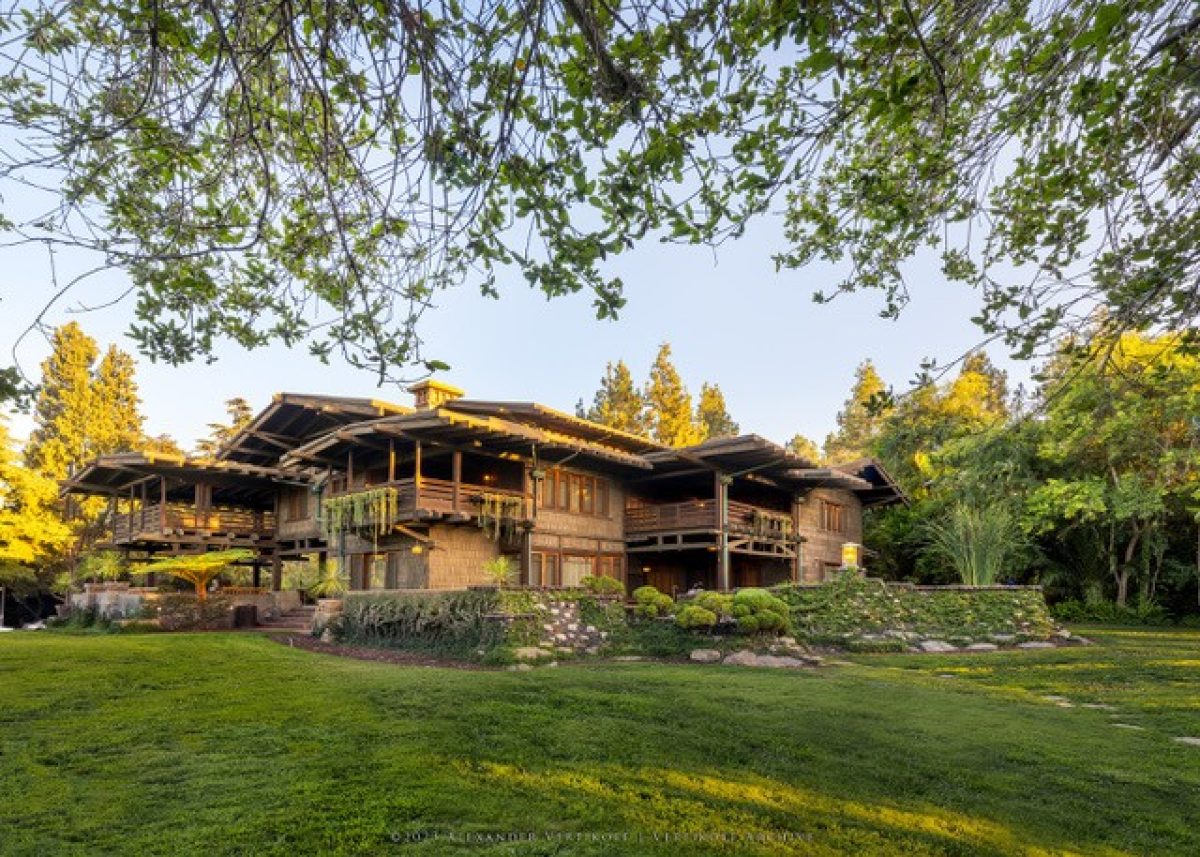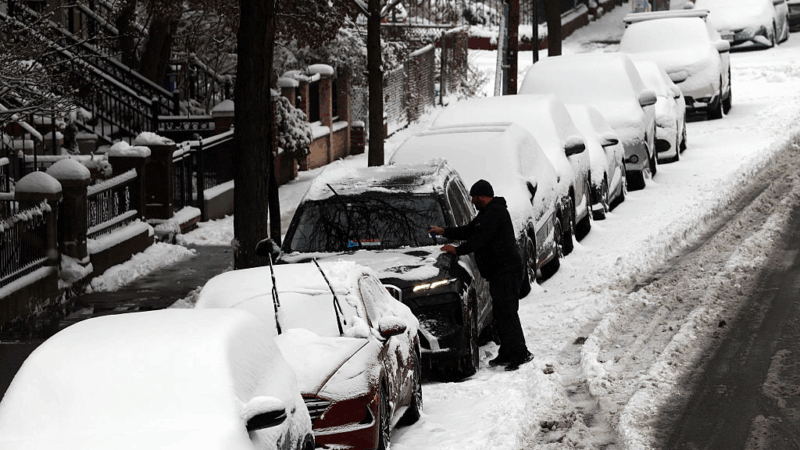Beloved historic landmarks navigate an uncertain future after the LA fires

The former home of one of the world’s most famous western novelists, Zane Grey, was a Mediterranean Revival house designed with high, wood-beamed ceilings and airy balconies.
“It had almost a cathedral vibe when you walked in,” said Nathaniel Grouille on a recent visit to the site. He bought the property with his wife in 2020.
It’s been almost two months since the Eaton Fire destroyed thousands of homes in Altadena, including several noted historic and cultural landmarks like this one, which was listed on the National Register of Historic Places in 2002.
During a visit in February, the shattered glass from the estate’s windows was still underfoot, along with blackened wood, twisted gutters and broken pieces of ceramic. All that the fire left standing are the sturdy concrete walls.
Gray was known in the 1920s and ’30s for his adventure novels set on the American Frontier, like Riders of the Purple Sage and The Lone Star Ranger. Inside, his house reflected his interest in the Old West and Southwest — and those charred concrete walls that remain still bear faint traces of his interests.
“You can see the white stencils made it through the fire, even though the paint itself is gone,” said Grouille’s wife Alice Carr, pointing to a wall painted with Hopi spiritual figures.
Weighing options for the Zane Grey Estate

Grouille and Carr are now facing a big question: How to rebuild the site in a way that preserves Grey’s legacy while protecting it from the inevitable future fires and other disasters resulting from the impacts of human-caused climate change?
Returning the property to what it was in Zane Grey’s day isn’t on the couple’s agenda.
“This structure was incredibly unique, using really high quality old-growth wood and products that just don’t exist today,” Carr said.
Grouille said they have no interest in using modern materials to build a Zane Grey Estate lookalike — “A sort of Las Vegas version of a historic house.”
Instead, they’d rather reframe the author’s legacy to make sense in an era where human-caused climate change creates increasing threats — perhaps by building new, resilient structures out of sustainable materials that architecturally nod to Grey’s personality and passion for the West.
“He mixed sort of a Teddy Roosevelt-type pragmatism with a great romance,” Grouille said. “That’s the kind of the thing you want to preserve.”
A familiar tension
Conservation experts are familiar with this tension.
“That can sometimes be a delicate balance,” said Seri Worden, Senior director of preservation programs with the National Trust for Historic Preservation.
Worden said adding a metal roof or removing flammable plantings may increase a historic landmark’s chances of surviving a wildfire. But these interventions, if not done carefully, can ruin what makes these places special.
“How can we ensure that we can adapt the historic materials without losing the power these places have?” Worden said.

This is a question that historic sites that escaped the flames from the recent fires are also asking themselves — such as The Gamble House. The 1908 property, owned by the City of Pasadena and a National Historic Landmark since 1977, is a crowning example of American Arts and Crafts design — a sprawl of redwood shingles and copper pipes.
It was under an evacuation warning during the recent fires; the team temporarily removed a few key artifacts as a precaution.

“We are an enormous wood structure. So fire makes all of us very nervous,” said Sheryl Scott, the site’s director of communications and operations.
Making complex decisions
Scott said The Gamble House staff had previously been focused on earthquake and flood mitigation. Now with the possibility of more fire danger in the future, her team has been making complex decisions.
One was whether to remove the beautiful but potentially hazardous creeping figs clinging to the façade. They decided no. Instead, the plan is to keep the nearby shrubs and trees trimmed.
Another has been figuring out how best to protect the buildings’ historic but extremely flammable shingles, also known as shakes. That’s a topic of ongoing investigation.
“We can’t replace our shakes with fakes,” Scott said. “The integrity of the structure, the historic content, is important to us.”

All of this work takes resources. There are pockets of foundation and donor money. Conservation groups like the Los Angeles Conservancy connect historic landmarks with experts such as architects and contractors willing to provide pro bono or reduced rate assistance.
But Scott said it’s a hard time for California landmarks to get grants for protecting or rehabilitating historic sites against disasters. The state’s Office of Historic Preservation told NPR it does not offer them. Federal funding sources like the National Park Service are also facing cuts under the Trump Administration.
“Everyone’s nervous about the amount of money that’s available,” Scott said.
With limited resources, Scott said her team is figuring out what to prioritize in order to keep The Gamble House standing for future generations.
“The ongoing care and long term survival of the house is always our main priority,” Scott said. “Every decision we make is examined through the lens of being responsible stewards.”
Audio and digital story edited by Jennifer Vanasco. Audio mixed by Chloee Weiner.
Jeffrey R. Holland, next in line to lead Church of Jesus Christ of Latter-day Saints, dies at 85
Jeffrey R. Holland led the Quorum of the Twelve Apostles, a key governing body. He was next in line to become the church's president.
Winter storm brings heavy snow and ice to busy holiday travel weekend
A powerful winter storm is impacting parts of the U.S. with major snowfall, ice, and below zero wind chills. The conditions are disrupting holiday travel and could last through next week.
Disability rights advocate Bob Kafka dead at 79
Bob Kafka was an organizer with ADAPT (American Disabled for Attendant Programs Today), a group which advocates for policy change to support people with disabilities.
‘It’s behind you!’ How Britain goes wild for pantomimes during the holidays
Pantomimes are plays based on a well-known story — often a fairy tale — which are given a bawdy twist. The audience is expected to join in throughout, shouting as loudly as they can.
Kennedy Center vows to sue musician who canceled performance over Trump name change
The Kennedy Center is planning legal action after jazz musician Chuck Redd canceled an annual holiday concert. Redd pulled out after President Trump's name appeared on the building.
Our top global photo stories from 2025: Fearless women, solo polar bear, healing soups
These stunning photos include a polar bear in a Chinese zoo, a teen in Zambia facing an uncertain future, Mongolian kids watching TV in a tent, a chef prepping a bowl of good-for-you soup.






